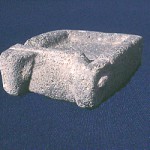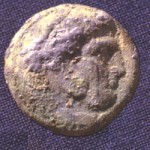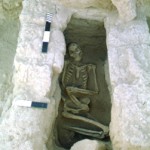Umm el-Marra was abandoned by the end of the Late Bronze period. While there is little reason to suppose that the site was occupied on any scale in the Iron Age, the discovery of a basalt receptacle with bull head protomes of Iron Age type in the North Area) as well as some Iron II sherds may imply a limited Iron Age use of the deserted tell.
Much more substantial reoccupation occurs in the Achaemenid Persian and Hellenistic periods (ca. 500-200 BC, Umm el-Marra Period I). In this era, remains are found all over the site and include a large building on the Acropolis and traces of sizeable structures (houses?) in the Northwest Area. Also common in this period are brick tombs and other burials situated on the edges of the tell.
The Achaemenid date of the earlier part of this occupation is well-illustrated by the discovery of a bronze “Achaemenid bowl” in a burial in the North Area, as well as an Aramaic graffito dated to ca. 400 BC written on a potsherd. Well-known Hellenistic pottery types, as well as occasional Seleucid coins, including a posthumous silver coin of Alexander the Great, confirm the Hellenistic date of the later part of the occupation.
On occasion, Roman period remains (1st century A.D.) have been observed below the surface at Umm el-Marra, especially on the acropolis, but the occupation must have been small-scale and “rural.” Evidence of later periods includes Late Antique or Early Islamic glazed potsherds recovered from a pit in the Acropolis East and pit graves of the Islamic period found on the edges of the site.



